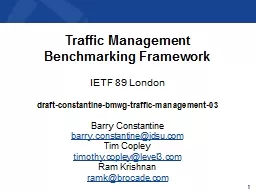

Management Benchmarking Framework IETF 89 London draftconstantinebmwgtrafficmanagement03 Barry Constantine barryconstantinejdsucom Tim Copley timothycopleylevel3com Ram Krishnan ID: 503197
Download Presentation The PPT/PDF document "Traffic" is the property of its rightful owner. Permission is granted to download and print the materials on this web site for personal, non-commercial use only, and to display it on your personal computer provided you do not modify the materials and that you retain all copyright notices contained in the materials. By downloading content from our website, you accept the terms of this agreement.
Slide1
Traffic
Management
Benchmarking Framework
IETF
89 London
draft-constantine-bmwg-traffic-management-03
Barry
Constantine
barry.constantine@jdsu.com
Tim Copley
timothy.copley@level3.com
Ram
Krishnan
ramk@brocade.comSlide2
Traffic Management Benchmarking Overview
Extends RFC 2544 benchmarking into traffic management functionality of network elements:
Classification / Prioritization
Policing
Queuing / Scheduling
ShapingSlide3
Revisions Incorporated into Draft-03
Based upon a review with Dean Lee, refined wording
to emphasize that
scope is to characterize / benchmark traffic
management
capabilities
U
sing
the metrics defined in the
draft, re-enforcing
that this test method is not a conformance
test
The draft was combed through substantially to clarify content, test flow and metric
definitions
AQM has been removed from the scope of this work, we want to bound the work to the more predominant traffic management functions that are being used by network operators (policing, queuing, shaping)Slide4
Traffic Shaper
Test (discussed in Vancouver)
Two (2) vendor’s equipment were configured to shape to 40 Mbps CIR with Burst Commited (Bc) and Burst Excess (Be) both equal to 20,000 bytes
Each shaper ingress queue configured to
handle 256 KB
(ensure no ingress drops)
Traffic generator sent a single 128,000 byte burst (back-back at GigE) while traffic receiver captured packetsVendor traffic shapers were compared according to the metrics defined in the traffic management benchmarking draft (results summary next slide)
Traffic Generator
Traffic Receiver
Vendor
Traffic Shaper
GigE
GigESlide5
Traffic Shaper Test Results
(discussed in VC)
Neither vendor dropped any packets
Vendor “A” shaped in system time intervals (~4 msec) while vendor “B” shaped according to the CIR transmission rate (~250 usec), see
Max
J
itterAlso related to timing interval, Vendor A “lumped” bytes (Average Burst Bytes) while Vendor B transmitted single frames (mostly*) at CIR rateVendor A also burst beyond Bc + Be, as high as 47,058 bytes in Trial 4Slide6
Additional Testing since Vancouver (1)
Tested the shaper test method in a major mobile operator lab
This operator was comparing the characteristics of several different vendor’s equipment for Ethernet backhaul
This operator was most interested in the burst size that the shaper would handle without loss at the egress
All of the draft metrics were deemed useful by the operator
Lost Packets, Out of Sequence, Packet Delay Variation, Shaper Rate, Shaper Burst Bytes, and Shaper Burst Interval
This operator suggested the usefulness of a “burst hunt” mode: the test would automatically derive the maximum burst size achievable in policer, queue, and shaper testsSlide7
Additional Testing since
Vancouver
(2)
The operator wanted to characterize the shaping function of the
Internet Router
and queue size of
Switch 2
Each device was tested independently; (1) characterize the egress behavior of the shaper (2) characterize the burst capability of the egress queueBoth the stateless burst tests and TCP layer tests were conductedMetrics of each test were used to compare different vendors and tweak pre-deployment settings
GigE to 100 Mbps
Egress queue
100 Mbps
Traffic shaper
GigE to 100 Mbps downshift
Switch 1
VPLS Switch
Internet
Router
Switch 2Slide8
Next Steps for the Traffic Management Draft
We seek the BMWG to formally adopt this personal submission as a chartered draft work
Finalize the Appendix of application test pattern definitions (HTTP, Email, SMB, etc.)
More review from BMWG members…